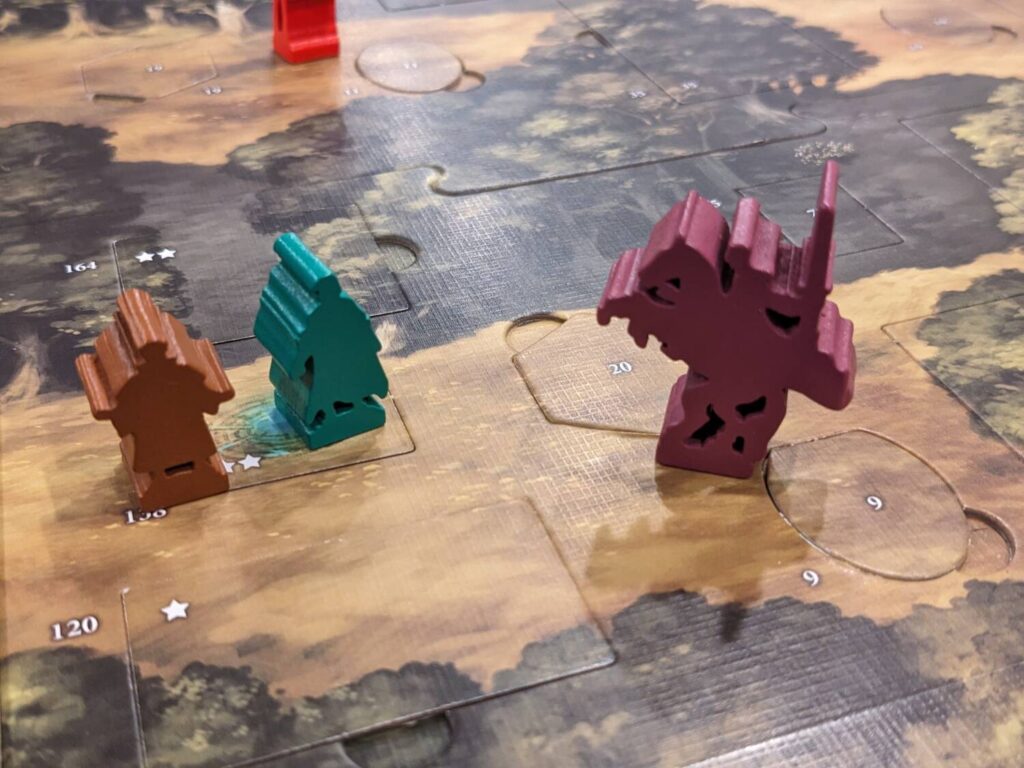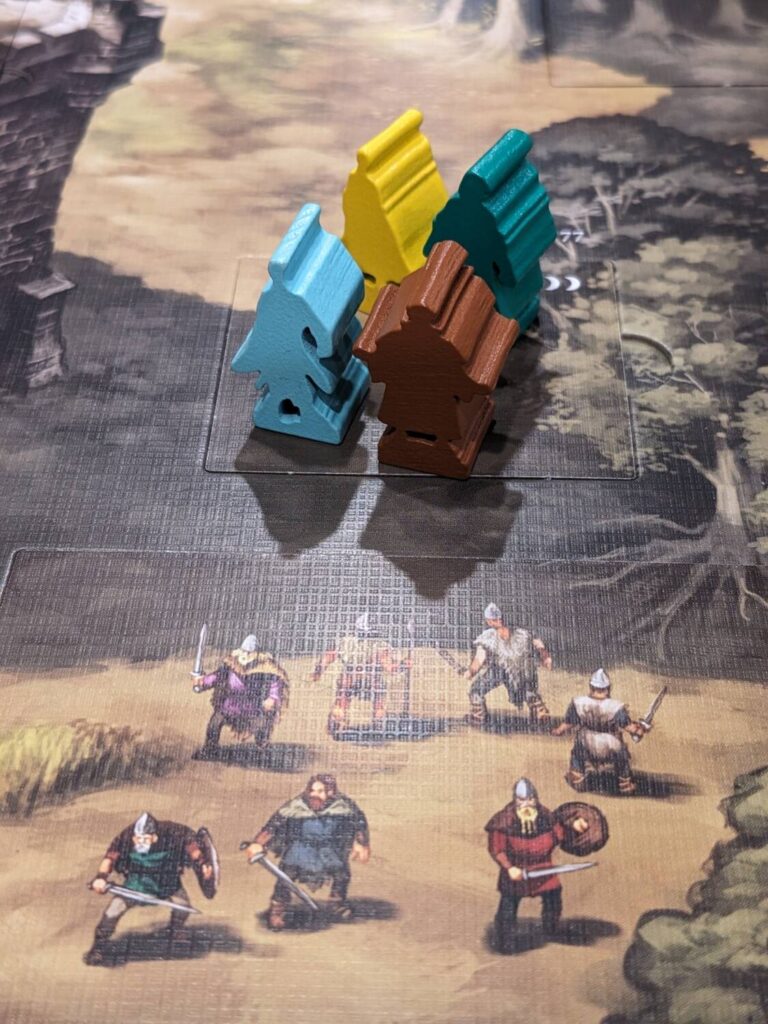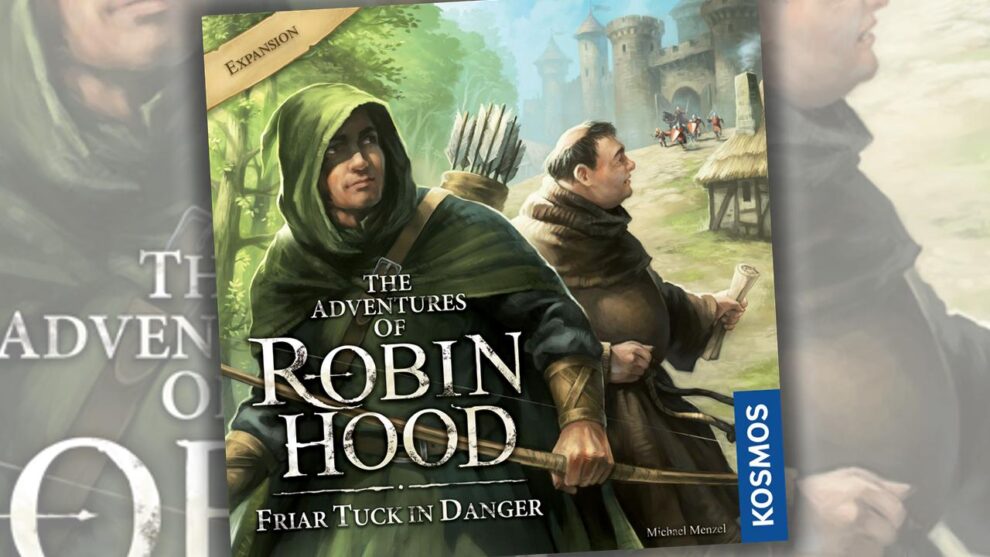Disclosure: Meeple Mountain received a free copy of this product in exchange for an honest, unbiased review. This review is not intended to be an endorsement.
There we were, down to the wire…Friar Tuck really was in danger.
The family had defeated two of the three Norsemen during the second half of the first chapter of Friar Tuck in Danger, the expansion to The Adventures of Robin Hood, published by KOSMOS. The game’s excellent action system, carried over from the base game, laid it out simply—we were down to our last turn, and my character, Will Scarlett, had to defeat the final Norseman or the team was going to lose the game.
Two years ago, the “team” was made up of just my wife and I, moving through the base game campaign as Robin Hood and Little John. Fast forward to the present, and the team has expanded—now my 10-year-old and 7-year-old wanted in, so we used all four playable characters for the expansion, including Will and Maid Marion.
Little John, with the help of new addition Friar Tuck—whose main power in the expansion’s first chapter allows adjacent characters to draw two extra cube draws, a massive boost—had defeated the first Norseman. Marion, thanks to a fancy new axe she was holding, made short work of the second Norseman. I had searched for, then discovered, the third Norseman, but bad luck meant I failed in my first attempt to take him out.
All I needed to do was draw five cubes (normally three, but I had an axe to boost my draw total) and hope that two of those five cubes were white, signifying two hits on my target. The draw bag was full of purple cubes (misses) thanks to the team’s earlier choices, by running around the map instead of walking, and drawing that dreaded purple event disc from the bag, which added more bad cubes to our chances.
I pulled out the first cube…white. The 10-year-old pumped their fist. The seven-year-old looked nervous. In part, this was a sign of “hanger”, because win or lose, dinner was ready and he was hungry. My wife tried to maintain the drama by rooting me on. “Come on, white cube! COME ON!!!”
I drew a second cube. White. Three of us jumped up in celebration. (The fourth went to get his slice of Costco pepperoni pizza, which we all know is incredible.) We had done it—success! The fine people of Sherwood Forest were safe, at least for now.
The Adventures of Robin Hood: Friar Tuck in Danger does everything the base game does, with mostly the same map, same movement system, same draw bag system, and a new storybook written by designer Michael Menzel. (Manzel also did all the art for the new game, too.) In another great example of “if it ain’t broke, don’t fix it”, Menzel and KOSMOS played this close to the vest with four new adventures/chapters here and it all works.

More Stuff? No…Mostly, More Stories
Friar Tuck in Danger’s biggest addition is the Friar Tuck character, although the Sheriff of Nottingham is also a new addition that is represented with bright red wooden meeple standees. Most everything else is what you remember from the base game. For a refresher on the rules, feel free to read my review of the original.
The great thing about the new game is the use of the base game’s map, with small changes to the removable tiles that are numbered on the board. About 20 of the base game’s tiles are swapped out for expansion tiles that represent new people just standing around in Sherwood Forest, or congregating in town and near the castle. In some cases, new baddies are swapped in for the guards from the base game, and a couple new items show up later too.
For the most part, the physical component differences are slight. You’re really here for more Robin Hood, more Prince John, more Guy of Gisbourne, more bow-and-arrow battles and more discoveries of the game’s plot points. The expansion uses a brand new quest book (a book that isn’t hardcover like the base game, which is a strange miss), and the board has expanded to include 10 large boards instead of just the eight from the base game, giving everyone more space to traverse the lands of 12th-century England.
And with only four chapters, Friar Tuck in Danger is short. In fact, we completed the game in just three sittings over the course of a single week. (Like the base game, Friar Tuck in Danger can be reset and branching narrative paths allow for a slightly different game with each playthrough.) You can make the game easier or harder by adding or subtracting extra red or gray discs, which accelerate the game clock or give out extra actions to a single player.
I think the balance is there even if you play the game straight up. Save for the first mission, the other chapters are won or lost right near the point when players are running low on Hope (the collective sense of dread of the community, like the base game). I loved the tension of nearly winning or losing in each scenario, so Menzel and the development team nailed this with the expansion.

Get It
For family-weight fun that can be enjoyed with almost anyone who can read, The Adventures of Robin Hood: Friar Tuck in Danger continues the incredible system created with the base game.
A big reason why I enjoyed the expansion? My entire family can play now and the system is so easy to deliver. Whose turn is it? Draw the next disc from the bag, and that’s who plays next (with the white disc still granting all players a chance to take an action). The game clock is easy to parse. Hiding in the shadows is still fun. Shooting arrows from a distance is still cool.
And determining your character’s next physical move is still a blast thanks to the way players place their medium and long-range movement tokens on the map. The kids adored this part of the design.
Menzel’s text is still breezy, and my 10-year-old handled much of the storybook duty during this campaign. Because of the player scaling, campaigns can start with four players but scale up or down with players lost or added (or dummy handed by those left behind, an easy lift). And none of our sessions took more than an hour, so we never lost the kids’ attention, in part thanks to the quick turn structure.
One negative that bumped this score down a point: the third chapter (i.e., 25% of the game) ends up being a bit of a chore. I won’t spoil anything here, but you will likely find the various tasks needed to complete this chapter a little clumsy because of the chapter’s twisty plot. The story was interesting, but the execution was not ideal.
You can find this expansion at some retailers for less than $20 USD. In that range, there’s not much I wouldn’t play, but the quality here elevates Friar Tuck in Danger to must-have territory if you are looking for a reason to get the base game back to the table. (A copy of the base game is required to play the expansion.)
The Adventures of Robin Hood: Friar Tuck in Danger doesn’t improve upon the system of the base game, because the base game system was already excellent. It was still a blast to take a trip back to Sherwood Forest and solve the mysteries of the expansion!












Add Comment